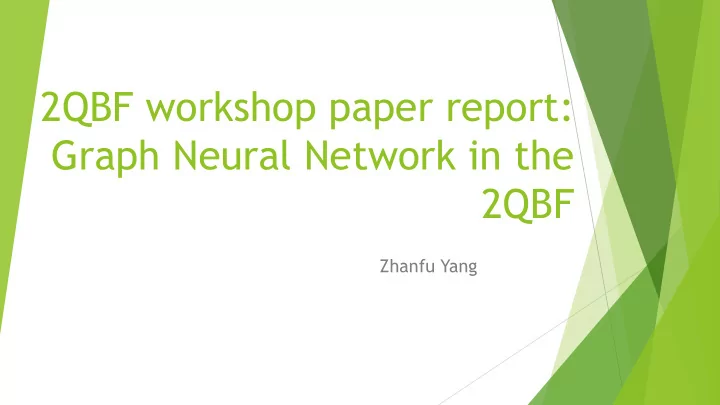

2QBF workshop paper report: Graph Neural Network in the 2QBF Zhanfu Yang
Content What is SAT u What is QBF/2QBF u GNN in SAT u GNN in 2QBF u What we find out u GNN-based heuristics in CEGAR-based solvers u Current work u
SAT Problem Built from variables, operators AND (conjunction, also denoted by ∧ ), OR u (disjunction, ∨ ), NOT (negation, ¬), and parentheses. A formula is said to be satisfiable if it can be made TRUE by assigning u appropriate logical values (i.e. TRUE, FALSE) to its variables. Given a formula, to check whether it is satisfiable. u [1] https://en.wikipedia.org/wiki/Boolean_satisfiability_problem
QBF Problem QBF is an extension of propositional formula, which allows quantifiers ( ∀ and u ∃ ) over the boolean variables QBF problems are PSPACE-complete, lies between NP-completeness of SAT u problems and the semi-decidability of predicate logic problems [1] Hans Kleine Büning and Uwe Bubeck. Theory of quantified boolean formulas. In Handbook of Satisfiability, 2009.
2QBF Formulae Furthermore, 2-QBF (QBF with only two alternative quantifiers) is u # $%&'()*) v ∑ " ∀ x1 ∃ x2 .sat. (x1 ∨ ¬x2) ∧ (¬x1 ∨ x2) u [1] Hans Kleine Büning and Uwe Bubeck. Theory of quantified boolean formulas. In Handbook of Satisfiability, 2009.
Why we choose 2QBF? The subclass 2QBF is worthy of study in its own right, away from the more u general context of QBF . 2QBF is a gentler generalization of SAT than general QBF , techniques that are u useful in SAT algorithms sometimes adapt more easily and more usefully to 2QBF than they do to QBF . [1] Darsh Ranjan, Daijue Tang, and Sharad Malik. A comparative study of 2qbf algorithms, 2014
Graph neural Network GNNs broadly refer to neural architectures that convey message flows over u graphs, which are devised to learn the embedding of nodes and graphs. denotes the hidden state of node v at the k th layer. u denotes the neighbors of node v. u
GNN in SAT Embedding for SAT . one kind of nodes represent all literals (boolean variables and u their negations, denoted as L ) , and the other kind of nodes represent clauses (denoted as C). Graph Representation of (x1 ∨ ¬x2) ∧ (¬x1 ∨ x2): u [1] Daniel Selsam, Matthew Lamm, Benedikt Bünz, Percy Liang, Leonardo de Moura, and David L. Dill. Learning. a SAT solver from single-bit u supervision. ICLR 2019
GNN Embedding in SAT Emb L and Emb C denotes embedding matrices of literals and clauses u respectively,
GNN in 2QBF (x1 ∨ ¬x2) ∧ (¬x1 ∨ x2) u
GNN Embedding in 2QBF Accordingly, in GNN architectures, the separated ∀ -literals and ∃ -literals are u embedded via different machine learning modules.
Experiment Evaluate: u SAT: u UNSAT: u We trained our GNNs with different amount of training data (40 pairs, 80 u pairs, and 160 pairs of satisfiable/unsatisfiable formulas) and different numbers of message-passing iterations (8 iters, 16 iters, and 32 iters), and then tested the converged models on 600 pairs of new instances.
Why Custom GNN failed? Difficulty in Proving UNSAT for Propositional Logic u (1) GNN-bases SAT solvers had trouble predicting unsatisfiability with high confidence (2)message-passing in GNN is rather similar to some incomplete SAT solvers GNN-based 2QBF Solver is Conjecturally Infeasible u [1]
Learn GNN-based HeuristicsI for 2QBF Traditional decision procedures (such u as CEGAR-based solvers (Rabe et al., 2018)) has a way to incrementally construct proof. However, it’s not being ranking. u
Experiment Ranking u The evaluations are done on 4 separate datasets u TrainU: 1000 unsatisfiable formulas used for training TrainS: 1000 satisfiable formulas used for training TestU: 600 unsatisfiable formulas used for testing TestS: 600 satisfiable formulas used for testing’ with 2 baselines: u • -: vanilla CEGAR without ranking • MaxSAT
Result-1 Ranking CANDIDATES/COunterexample
Result-2 Combination
Current work Larger Dataset(Experiment) u Difficulty in Proving UNSAT for Propositional Logic(proof) u Powerful of GNN Embedding in the 2QBF problem(proof) u
Thanks
Recommend
More recommend